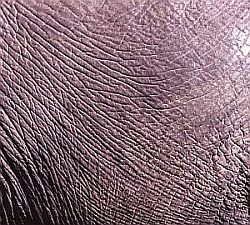| Explanation:
Wrinkles, splotches, stripes, and
scales!
You are looking at four examples of how large animals from southern Africa
have evolved some interesting, and very useful, skin patterns.
African
elephants, like their Asian
elephant cousins, have nearly naked skin except for scattered bristles and
sensory hairs. The skin
is thick and leathery, and able to withstand extreme conditions of water
and dry hot sun. The modern elephant,
in fact, evolved
in Africa, shifting from very wet marshlands to drier, open
environments. Their thick skin has only rudimentary pigmentation
of melanin
varying from dense black to pale gray, brown, or rarely sensitive
unpigmented pink. skin except for scattered bristles and
sensory hairs. The skin
is thick and leathery, and able to withstand extreme conditions of water
and dry hot sun. The modern elephant,
in fact, evolved
in Africa, shifting from very wet marshlands to drier, open
environments. Their thick skin has only rudimentary pigmentation
of melanin
varying from dense black to pale gray, brown, or rarely sensitive
unpigmented pink.
Giraffes
vary in the patterns and colors of the patches on their hide, the exact
pattern being unique in each animal like giant fingerprints.
Of the  8 races of giraffe,
the reticulated race reticulata of north Kenya is the most
distinctive, with thin lines separating the dark patches, and the Masai
giraffe race tippelskirchi of East Africa has the most irregular
pattern. The patterns likely help to camouflage
the animals from predators such as lions. Despite their size, giraffes
become surprisingly difficult to spot when they step behind Acacia and Combretum
trees on which
they feed. 8 races of giraffe,
the reticulated race reticulata of north Kenya is the most
distinctive, with thin lines separating the dark patches, and the Masai
giraffe race tippelskirchi of East Africa has the most irregular
pattern. The patterns likely help to camouflage
the animals from predators such as lions. Despite their size, giraffes
become surprisingly difficult to spot when they step behind Acacia and Combretum
trees on which
they feed.
Zebras
have a background of white to buff, with dark stripes that vary
geographically and individually (again like fingerprints), being most complete and bold in the equatorial boehmi race. In southern
Africa, the antiquorum and burchelli races lack stripes on the
lower legs and belly, and have shadow stripes between the black torso
stripes. The stripes, which seem bilaterally
symmetric (mirror
images on each side), help to hide the animals in woodland
thickets with broken sunlight, or in thick tall grasses. One
theory why zebras are black and white instead of investing in the extra
energy to produce colored stripes, is because its primary predator, the lion,
is color-blind. Rudimentary striping camouflage can be found
in other ungulate
species.
complete and bold in the equatorial boehmi race. In southern
Africa, the antiquorum and burchelli races lack stripes on the
lower legs and belly, and have shadow stripes between the black torso
stripes. The stripes, which seem bilaterally
symmetric (mirror
images on each side), help to hide the animals in woodland
thickets with broken sunlight, or in thick tall grasses. One
theory why zebras are black and white instead of investing in the extra
energy to produce colored stripes, is because its primary predator, the lion,
is color-blind. Rudimentary striping camouflage can be found
in other ungulate
species.
 Nile
crocodiles are armored with large
scales, like all reptiles. Their coloration helps them blend into
murky river waters and pools, where only a snout
or eyes may show, as they await
their prey in ambush. Nile
crocodiles are armored with large
scales, like all reptiles. Their coloration helps them blend into
murky river waters and pools, where only a snout
or eyes may show, as they await
their prey in ambush.
These four species illustrate how skin
patterns have evolved according to where an animal lives, what it eats, what
eats it, and probably the need to be recognized individually. These
are ecological relations that would be impossible to learn in captive or
zoo populations ... one has to observe the animal in its selected, native
habitat in the wild to understand why it appears as it does.
Source:
Estes, R. D. 1999. The safari
companion: a guide to watching African mammals. Chelsea Green Publishing Co.,
White River Junction, VT. 459 pp.
Kingdon, J. 1997. The Kingdon
field guide to African mammals. Academic Press, San Diego. 464 pp.
New information:
Caro, T. 2005. The adaptive significance of coloration in mammals. BioScience 55(2):125-136.
|

